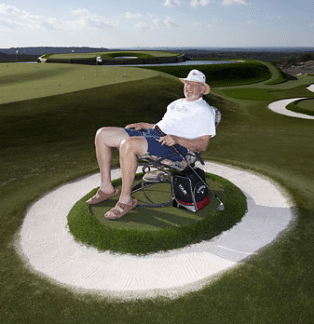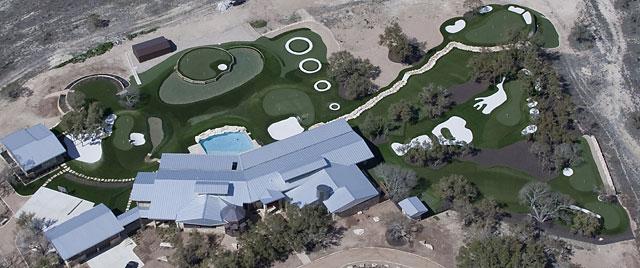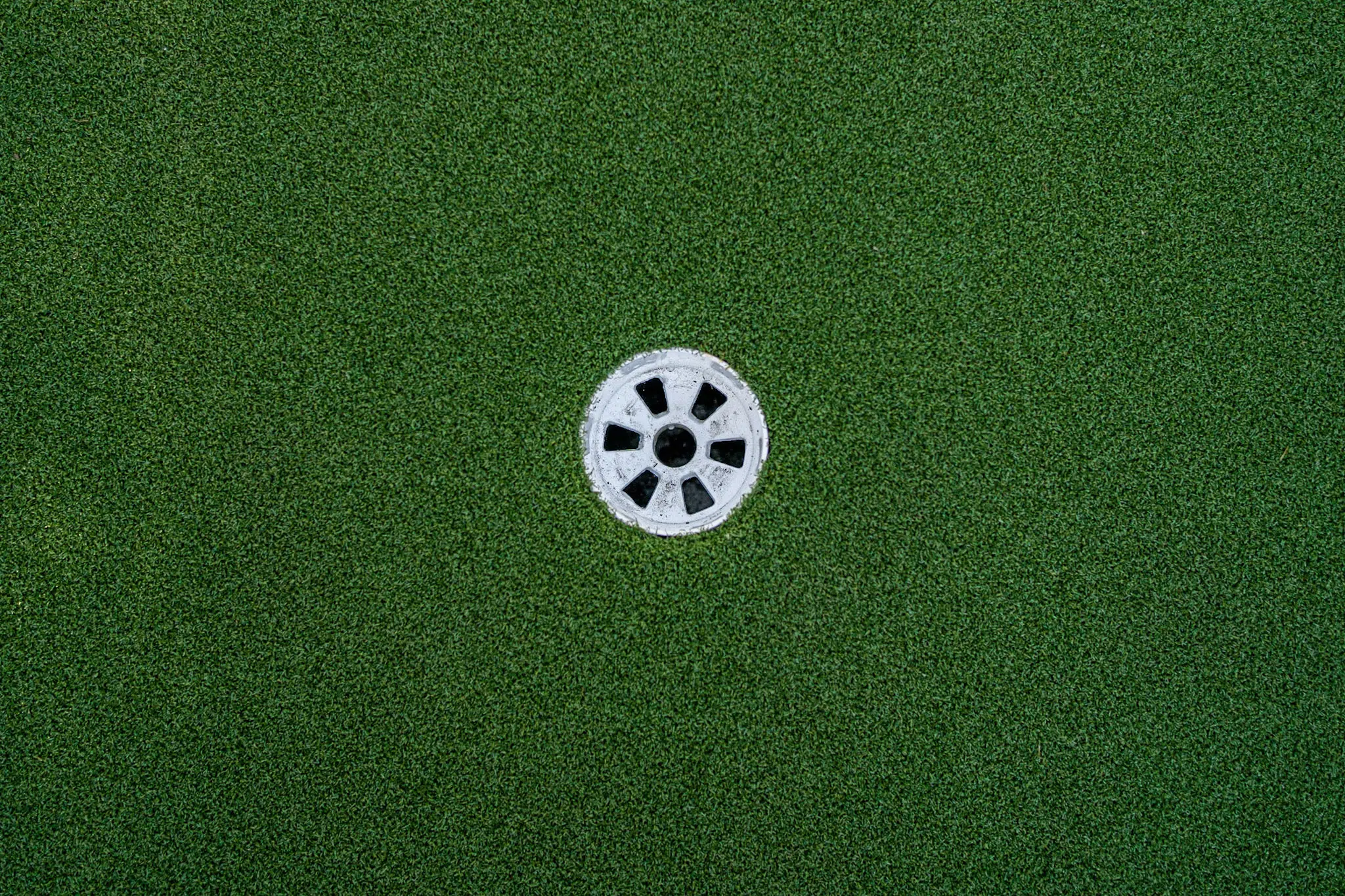
Dave Pelz backyard golf laboratory
Austin, TX — The house where the short-game guru Dave Pelz lives, in the foothills west of Austin, Tex., is a golf geek’s Shangri-La, with practice grounds designed to fit its owner’s fantasies. Just outside his back door, Pelz can take dead aim at faithful reproductions of his favorite targets: the 12th green at Augusta, fronted by a creek and an alabaster bunker; the 17th at Sawgrass, ringed by water; and the 14th at Pebble Beach, with its tiny tabletop, as forgiving as the roof of a VW Bug.
When Pelz and his wife, JoAnn, moved in last year, she chose the china, but he had final say on the elaborate landscape, which also features tributes to the 17th at Pebble, the 13th at Augusta and the Road Hole at St. Andrews, along with enough practice greens, skewed at different angles, to keep Ben Crenshaw endlessly entertained.
The short-game facility extends across two-acres of SYNLawn synthetic turf that never requires watering or mowing, and that features a special patent-pending underlayment that allows his putting surfaces to receive shots like real bent – and Bermuda grass greens.
On any given morning, when he isn’t writing books, or tweaking a new gadget, or working with Phil Mickelson in the run-up to a major, Pelz can be found at his rear doorstep, in his trademark bucket hat, with a bag of balls beside him, fine-tuning the array of precision shots on which he’s made his name and a three-decade-plus career.
The Tour pro D.A. Weibring, a Pelz protégé and friend, describes the property as “Pelz’s playground” — a phrase the man himself dismisses.
“It’s more like a laboratory,” Pelz says. “A place for pushing forward with my work.”
It takes a different kind of person to regard a golfer’s dreamscape as a research center, but then Pelz has always had a stats-jammed mind of his own. “Not everything Dave has said has been embraced right away,” says 19-time Tour winner Tom Kite, who worked with Pelz in the late ’70s and early ’80s. “But people eventually came around to seeing that what he said was right. When you look at the long term, you realize the immense impact that he’s had.”
Since the mid 1970s, when he left a job as a NASA research scientist to immerse himself in golf research, Pelz has unearthed answers in the data while others were still digging for them in the dirt. The truth that serious players hold today—that you drive for show, but chip and pitch for dough—was far from self-evident when Pelz got started. The term itself—”short game”—didn’t even exist. By treating every course as a laboratory, and every round as part of a grand experiment, Pelz not only showed that short shots deserve their own classification—he proved that they’re what matter most.
“Joe Blow golfer may still go out and smack drivers on the range for an hour and think he’s accomplishing something,” says Andy North, a two-time U.S. Open winner-turned-ESPN analyst, and one of the first Tour pros to embrace Pelz’s teachings. “But throughout the game, there’s a deeper understanding of how golf is really played. Much of the credit for that goes to Dave Pelz.”
Pelz has evolved from a one-man operation, conducting esoteric studies from the far edge of the fairways, into an institution—an author and inventor, a global speaker and instructor, with short-game schools in this country and abroad. Now 72, he has penned six books, holds 17 golf-related patents and has fathered inventions of immense impact, among them the 60- and 64- degree wedge and the two-ball putter, one of the all-time best-selling clubs of any kind.
Pelz’s insights have influenced Tour pros and amateurs alike. His stable of students, with 19 majors under their collective belts, has included Vijay Singh, Paul Azinger, Lee Janzen, Michelle Wie, and, most famously, Mickelson, who turned to Pelz for help in late 2003, months before he won his first Masters. “I was 0-for-43 in majors before I met him, and I’ve won four, plus a Players Championship, since,” Mickelson says. “That says it all about him in my book.”
Pitching balls in his backyard, Pelz cuts the profile of a man in his natural setting. But like the space probes that he once designed for NASA, he has traveled a long way to get where he is today.
Pelz was born in Indiana, raised in Kentucky and grew to 6 feet 5. He became a standout athlete, earning a four-year golf scholarship to Indiana University. His Big Ten career was sound but unspectacular, notable mostly for the record he compiled against an Ohio State star named Jack Nicklaus: zero wins and 22 losses. Enough golfers not named Nicklaus also beat him that, by graduation, Pelz had reconsidered his Tour ambitions.
With a degree in physics, Pelz landed a job at NASA, where he built mass spectrometers, particle-measuring devices that were instrumental to research into other planets’ atmospheres. Interesting work. But the more he tinkered in a lab, the more he daydreamed of the course. “I realized I was a golfer who loved physics,” Pelz says, “rather than a physicist who loved golf.”
Where college taught him the nuts and bolts of science, NASA schooled him in the rigors of sound research. One subject of inquiry consumed him: How were some players with unimpressive swings winning on golf’s biggest stages?
Take 1969 Masters champ George Archer, a subpar ball striker by Tour standards. Or Gay Brewer, whose swing looked a little bit like a helicopter in a death spiral. Somehow, both won green jackets. “It occurred to me,” Pelz says, “that if I couldn’t tell Gene Littler”—who had a famously silky swing—”from Gay Brewer, then I really didn’t understand the game.”
In 1976, Pelz resigned from NASA and focused his scientific acumen on the PGA Tour. For the next three years, notepad in hand, he bounced from one event to another, jotting down the results of every shot he saw. His empirical approach to golf, in a pre-ShotLink era when the game was ruled by received wisdom, made Pelz an oddball. It also produced results.
That the findings hardly come across as earthshaking today is a testament to the revolution they inspired. Pelz’s data showed that the short game—shots of 100 yards or less—was 60 to 65 percent of golf, a majority share that also happened to be the weakest part of most players’ games. From beyond 100 yards, the average Tour pro missed his target by a 7 percent margin (a 14-yard error, for example, on a 200-yard shot). From inside 100 yards, though, that figure jumped to 16 to 20 percent. For the game’s best players, straying right or left on wedges wasn’t the problem. It was distance control. “A guy who tugged a 60-yard shot 10 yards offline would hang his head in disgust,” Pelz says. “But he’d fly one over the flagstick, 20 yards long, and be thinking he’d hit a great shot.”
The logical conclusions his research led to amounted to a challenge to the old world order.
Before Pelz, players carried 1-irons, 2-irons, 3-irons—an arsenal of clubs to cover an array of long-distance increments—and only one club to handle everything from 100 yards and in. Pelz recommended filling that gap. Many Tour pros heeded his counsel, including Kite. In 1981, Kite became one of the first Tour pros to carry a 60-degree wedge and went on to lead the money list and win the Vardon Trophy for low scoring average.
As Pelz’s influence seeped through the pro ranks, his reputation spread to well-heeled amateurs. In 1982, he opened his first short-game school, in Abilene, Tex., fetching up to $1,500 a head for a full-day session with a foursome. But instruction wasn’t his passion. “I was trying to learn the game,” Pelz says, “not trying to teach it.”
To support his research, Pelz focused on equipment design. He made a good inventor but a lousy businessman. Among his financial missteps was the two-ball putter, the design he dreamed up in 1986, only to sell the rights a decade-plus later, to Callaway Golf, for $250,000. It seemed like a good deal at the time, but in the years since, Callaway has sold 5 million of the putters.
The bottom line could be better. But it could also be worse. “Dave Pelz” is an integrated brand that extends not only to his books, clinics and schools but also to training aides, equipment, and apparel. Even the family’s Bedlington terrier, PEDO, falls under the company umbrella; his capitalized name is an acronym for Pelz Executive Dog Officer.
Like his restless dog, Pelz rarely sits still, often grinding on his research between 1 a.m. and 4 a.m. The results fill thousands of pages in books, magazines and scientific journals, and while all his theories are grounded in science, his approach is not as rigid as his background suggests. “He’s a scientist, but it’s not his way or the highway,” Weibring says. “He’ll say, ‘This is what my research has told me. How does it work for you?’ “
Case in point is the Pelz-Mickelson partnership, a study in contrasts that pairs golf’s top science guy with its ultimate feel player. When they first teamed up, in 2003, Mickelson had a rep as a short-game magician whose tricks failed him in majors. Pelz being Pelz put those impressions to an objective test.
The result was something of a myth-buster moment. Mickelson, it turned out, while spectacularly good on spectacular shots, was surprisingly ordinary at ordinary ones. Leave him short-sided with a flop shot over water, and no one was better. But the prospect of a more straightforward pitch turned Mickelson into a middling player, with a conversion rate in the Tour average of 55 to 65 percent. “People think of Phil as this freakish natural talent,” Pelz says. “The truth is that he’s a coordinated guy, but he still has to practice. The reason he was ordinary at these ordinary shots is that he paid virtually no attention to them.”
Mickelson started working on simple chips and pitches and now boasts a conversion rate north of 80 percent, among the highest on Tour, Pelz says. Course management is another matter, one on which the two butt heads. Pelz cringes when he thinks of Mickelson’s famed 6-iron from the pine straw on the 13th hole in the 2010 Masters. As he sees it, no shot is worth taking if a player can’t pull it off nine times out of 10.
Mickelson takes a different tack, Pelz says. “When we started working together, Phil believed that if he was capable of hitting a shot, he should try it, no matter what the odds were. Since then, he’s moved more toward a 50 percent guy. If he thinks he can pull it off half the time, he’s going to do it. That’s still too risky in my book, but that’s Phil. I’m not trying to turn him into Dave Pelz.”
At the same time, Pelz’s star pupil has rubbed off on him, or so it seemed one morning in the Texas foothills, as Pelz stood in his yard, aiming at his homage to Augusta’s 12th. The shot he faced was testy: an awkward 40-yarder over a creek to a pin tucked right. The Pelzian play—that is, the percentage play—was to the center. But Pelz was feeling frisky. Lob wedge in hand, he waggled, swung. The ball settled two feet from the stick.
“Not the smart shot,” Pelz said, smiling. “But every now and then you’ve got to have some fun.”











